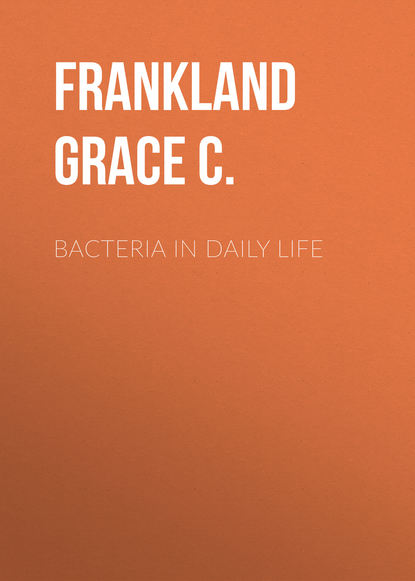По всем вопросам обращайтесь на: info@litportal.ru
(©) 2003-2024.
✖
Bacteria in Daily Life
Настройки чтения
Размер шрифта
Высота строк
Поля
To return, however, after this somewhat lengthy digression, to the question of dust and its bacterial properties, we have learnt enough to enable us to realise that the movement for the migration of the working-classes from crowded streets to rural districts, in which Mr. George Cadbury has played so practical and important a part in the creation of his model village, with its gardens and open spaces, some five miles from the city of Birmingham, is, if only bacterially considered, a very real barrier against the dissemination of disease, for the denser the population, the greater will be the crowd of bacteria, and the greater the chance of pathogenic varieties being present amongst them. Again, we know that sunshine is one of the most potent germicides with which nature has provided us;[2 - See "Sunshine and Life."] and it requires no effort of the imagination to realise how, in the gloomy back courts and crowded tenements of our great smoke-laden cities, bacteria succeed in obtaining a firm hold on their surroundings, and, in the shape of spores, attaining an undesirable and hoary old age, in which they are in some cases almost indestructible. Fräulein Dr. E. Concornotti has shown that this is no figment of fancy only, for she has recently made a special and very elaborate study of the distribution of pathogenic or disease bacteria in air, searching for them in the most varied surroundings, such as prisons, schools, casual wards, etc., with the result that, out of forty-six experiments in which the character of the bacteria found was tested by inoculation into animals, thirty-two yielded organisms which were pathogenic. Dr. Concornotti concludes her valuable memoir by stating that her investigations proved conclusively that the dirtier or more slumlike the surroundings, the greater was the frequency with which she found bacteria associated with disease in the air.
Messrs. Valenti and Terrari-Lelli have quite recently been able fully to endorse these statements in the results they have obtained in their systematic study of the bacterial contents of the air in the city of Modena. In their report they state that the narrower and more crowded the streets, the greater was the number of bacteria present in the air, and the more frequently did they meet with varieties associated with septic disease.
Numerous detailed investigations have also been made of the bacterial contents of the dust in hospitals. That cases of infection arising within hospital precincts are of no uncommon occurrence may be gathered from the observations made by Lutand and Hogg, who report no fewer than 2,294 such cases having arisen in the space of six years in certain Paris hospitals, whilst Solowjew records 1,880 cases as occurring in the space of four and a half months in the St. Petersburg city hospital. Solowjew made a special study of the bacterial contents of dust collected in hospitals, and states that 41·8 per cent. of the samples examined contained disease germs. The degree of infection possessed by dust in such surroundings must, of course, depend upon the degree of cleanliness which characterises the management of any particular institution; and such investigations as the above can only help to emphasise the immense importance of common cleanliness and the reasonableness of taking every precaution possible in the disinfection of utensils, etc.
Some years ago Messrs. Carnelley, Haldane, and Anderson carried out an elaborate series of investigations on the air of dwelling-houses in some of the poorest parts of Dundee. The samples were taken during the night, between 12.30 a.m. and 4.30 a.m., and in their report the authors state that the one-roomed tenements were mostly those of the very poor; "sometimes as many as six or even eight persons occupied the one bed," whilst in other cases there was no bed at all. As regards the number of bacteria present in the air in these one-roomed houses, an average of several examinations amounted to sixty per quart; in two-roomed houses it was reduced to forty-six, and in houses of four rooms and upwards only nine micro-organisms in the same volume of air were discovered.





